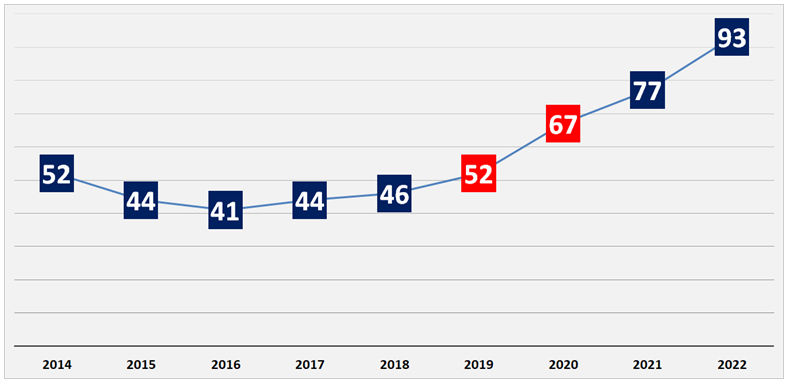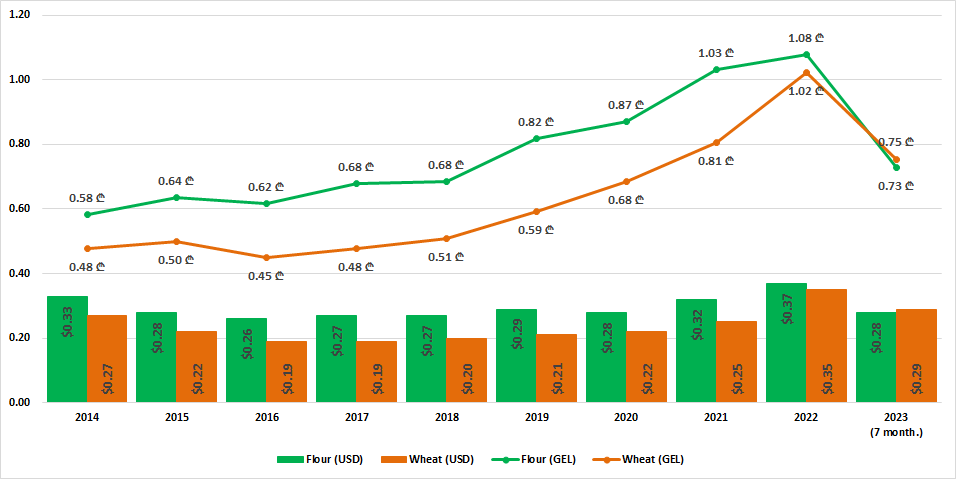Giorgi Botkoveli: “The price of the Georgian wheat this year (2023) is GEL 0.45 whilst it was GEL 1 three or four years ago and bread cost GEL 1-1.2 then and also today.”
Verdict: FactCheck concludes that Giorgi Botkoveli’s statement is MOSTLY FALSE.
Resume:
The first part of the statement about halving the price of Georgian wheat is not true. In 2019-2020, the price of Georgian wheat was GEL 0.52 and GEL 0.67, respectively, whilst the current price is GEL 0.59. Three or four years ago, the price of the Georgian wheat was not GEL 1; it was this price only in 2022 (GEL 0.93). There is a similar situation in terms of imported wheat as well. In 2019-2020, its price was GEL 0.59 and GEL 0.68,[1] respectively, whilst the current price is GEL 0.75. The wheat price surpassed the GEL 1 threshold only in 2022. Therefore, the claim that wheat has become considerably less expensive is not true.
It is also false to claim that the price of bread has not changed. In August 2023, bread became 10% cheaper as compared to the same period of the precious year, although it is still significantly expensive as compared to previous years. In particular, the price of bread increased by 36% as compared to August 2019 which is a 32% growth as compared to August 2020. In this case, the MP made a mistake which harms his own claim (in three-four years, wheat became less expensive but this was not reflected in lower prices for bread), although this will not negatively affect FactCheck’s verdict.
An analysis of the setting of the price of bread goes beyond the limits of this article.[2] Therefore, FactCheck will refrain from engaging in this discussion, particularly in view of the fact that expenses for producing a product (including bread) only have a limited effect on the price of a final product (including bread) under a market economy. On the other hand, it is possible that market pricing is determined to a certain extent by the government’s formal or informal interference which also complicates drawing straightforward conclusions. However, linking price of Georgian wheat and the price of bread in Georgia is in any case incorrect. The final setting of the price of bread is affected by taxes, salary expenses, utilities and in some cases rent and the margin of profit. The price of locally produced wheat is only one component for setting the price of bread. At the same time, the price of Georgian wheat itself cannot be determined independently and is largely affected by the value of imported wheat and flour.[3] Of additional note is that Georgia is largely import-dependent when it comes to wheat and wheat products. Therefore, the impact of local production on the price of bread as a final product is negligible and not a major factor.
Given all the aforementioned, FactCheck concludes that Giorgi Botkoveli’s statement is MOSTLY FALSE.
Analysis
On 5 September 2023, member of the United National Movement, Giorgi Botkoveli, in his speech before the Parliament, talked about the social situation in the country and stated (from 2:12:10): “In the case of wheat, I would like to say that this year the price of Georgian wheat is GEL 0.45 whilst three, four years ago, the price was GEL 1. The price of bread was GEL 1-1.2 then and it costs the same now and whose fault is it that the price of wheat is cheap or why did the price of bread not become cheaper?”
In 2014-2022, the price of wheat was never GEL 1 according to the National Statistics Office of Georgia. Four years ago; that is, in 2019, one kilogram of wheat was GEL 0.52 and GEL 0.67 in 2020. In 2021, the price increased to GEL 0.77 and further to GEL 0.93 in 2022. As the year 2023 is not yet over, the current price may change before January and it cannot be verified with an official document at this stage. According to BM.GE, which relies on information from the Association of Wheat and Flour Producers of Georgia, the price of Georgian wheat in July was GEL 0.59.
Graph 1: Price of One Kilogram Georgian Wheat in GEL

Source: National Statistics Office of Georgia
In terms of the interdependence of the price of Georgian wheat and the price of bread, of important note is that the share of Georgian wheat in the total consumption is around 20% with imported wheat and flour accounting for the rest. The import is mostly carried out from Russia. Since 2021, Russia has increased its export tax on wheat which made it more profitable for Georgian importers to import flour instead of wheat. In 2017-2020, flour import was fluctuating within the margins of 11,000-17,000 tonnes which increased to 38,000 tonnes in 2021 and 182,000 tonnes in 2022.
In recent years, local production of wheat ranges from 100,000 to 155,000 tonnes. However, exports of both wheat and flour are minimal and so imports added to local production basically amount to the total consumption.
The price of Georgian wheat increased by 79% in 2019-2020 - GEL 0.52 to GEL 0.93. In the same period, the price of imported wheat increased by 72% - from GEL 0.59 to GEL 1.02 whilst the price of flour increased by 32% - from GEL 0.82 to GEL 1.08 per kilogram.
The price of imported wheat/flour has a significant influence on the final price of bread as compared to local wheat/flour which in turn determines the price of Georgian wheat. Additional factors include taxes, payroll, utilities, distribution and rental costs to which the profit margin at each step (grinding, baking, distribution, sales) is added.
Graph 2: Price of Imported Wheat and Flour

Source: National Statistics Office of Georgia, National Bank of Georgia, author’s calculations
Since 2021, electricity tariffs have increased by 55% for residential customers. Natural gas has also become more expensive, although the natural gas price increase has not affected bread producers. The extent to which salaries have increased specifically in bread factories or small bakeries is unknown, although labour remuneration in 2022 is 41% and 34% higher as compared to 2019 and 2020, respectively.
In January-July 2023, the price of imported wheat (converted to GEL) decreased by 26.1% and the price of imported flour by 32.5% as compared to the previous year. As compared to the prices of 2019-2020, imported flour is 13.7% cheaper whilst imported wheat is 18.2% more expensive. On the other hand, as reported by the National Statistics Office of Georgia, the price of bread in August of this year was cheaper by 10% as compared to the same period of the previous year and increased by 36 and 32%, respectively, as compared to 2019-2020.
When the ingredients needed for baking bread became more expensive, bread also became more expensive, although the percentage increase was lower. The same happened when prices became less expensive. The decreasing and then increasing profit margin by producers during the period when the price of bread ingredients spiked was one of the probable reasons for this among other factors. However, an evaluation of real impacts requires relevant fundamental research which goes beyond this article’s boundaries.
Giorgi Botkoveli’s information that the price of Georgian wheat three-four years ago was GEL 1 as well as claiming that the current price is GEL 0.45 is false. It is also false that the price of bread has not changed in this period and the argument itself that the retail price of bread should be linked with the price of Georgian wheat is also wrong. Given the factual inaccuracies and the incorrect assumptions, FactCheck concludes that Giorgi Botkoveli’s statement is MOSTLY FALSE.
[1] According to the average annual exchange rate.
[2] The pricing policy in this market (wheat, flour, bread) and the role of possible formal or informal interference from the state/government as well those of market forces are not immediately clear.
[3] If the imported wheat or flour becomes less expensive, the price of Georgian wheat will change accordingly. Otherwise, it cannot be sold and if the imported wheat price is rising, Georgian wheat will also follow suit.








